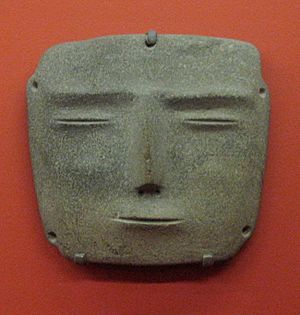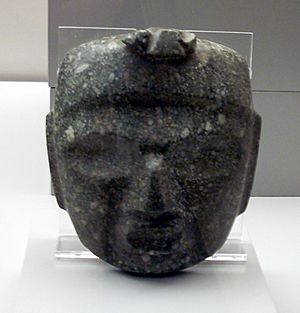Mezcala culture facts for kids


The Mezcala culture was an ancient civilization in Mesoamerica. It was located in the state of Guerrero, in southwestern Mexico. This area is near the upper Balsas River.
We don't know a lot about the Mezcala people. Experts believe they lived between 700 BC and 200 BC. Their culture also continued into the Classic period, from about 250 AD to 650 AD. During this time, they lived near the large city of Teotihuacan.
Archaeologists learn about the Mezcala culture in different ways. They study artifacts found during digs. They also look at art pieces that were taken from ancient sites. Many Mezcala sculptures were found at the Aztec city of Tenochtitlan. These were offerings left by the Aztecs.
Contents
Discovering the Mezcala Culture
The Mezcala region has many ancient objects. Sadly, many of these items have been taken by people looking to sell them. This makes it harder for archaeologists to study the culture.
The state of Guerrero has not had many professional digs. Because of this, ancient cultures there are not well understood. Only one Mezcala site from the Preclassic period has been properly studied. This site is called Ahuinahuac.
Archaeologists have also dug at Classic period Mezcala sites. These include Organera Xochipala and El Mirador. Most of what we know about Mezcala art comes from sculptures. These are often made from andesite or serpentine stone.
Mezcala History and Influence
Archaeologists have pieced together the Mezcala culture's story. They used information from digs and art found in other places. The Mezcala culture was based in southwestern Mexico. It was in the Guerrero state, near the upper Balsas River.
Experts think the culture started around 700 BC. It lasted until about 200 BC. It then continued into the Classic period, from 250 AD to 650 AD. During this time, the big city of Teotihuacan grew to the north.
The Mezcala area was greatly influenced by Teotihuacan. But the Mezcala culture also influenced Teotihuacan. Ideas and goods moved between both regions.
Societies in western Mexico were often organized as chiefdoms. This was different from Central Mexico, where large states were forming. However, the Mezcala area showed influences from Central Mexico. For example, towns along the Balsas River had pyramids. They also had central plazas and ball courts.
Later, the Aztec people valued Mezcala sculptures. They found these artworks and used them as offerings. Many Mezcala pieces were found at the Great Temple in Tenochtitlan. This temple was built in the 14th and 15th centuries. Over 56 masks and 98 small figures were found there. Some figures were carefully placed in stone boxes.
Mezcala Sculpture and Art
Mezcala sculptures are known for their unique style. They often have simple, abstract faces. Features like eyes and mouths are shown with lines or changes in the stone's surface.
The art style of the Mezcala culture might have been influenced by the Olmecs. In turn, Mezcala art may have helped shape the sculptures of Teotihuacan. Teotihuacan was a major city in the Valley of Mexico.
See also
 In Spanish: Cultura del Mezcala para niños
In Spanish: Cultura del Mezcala para niños


